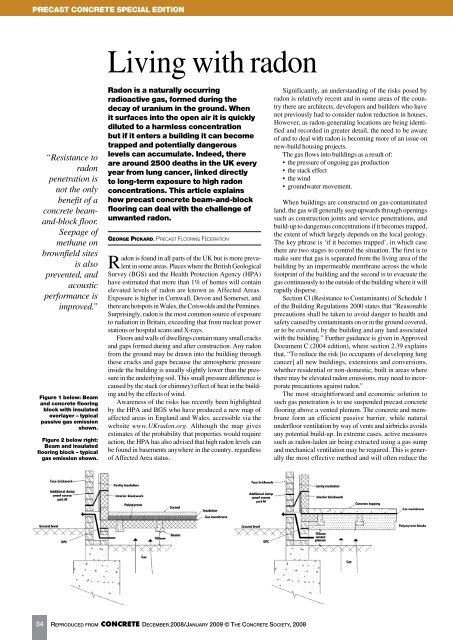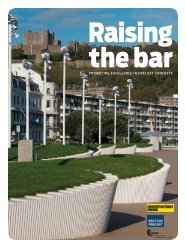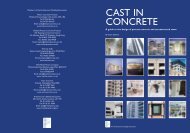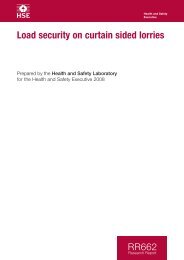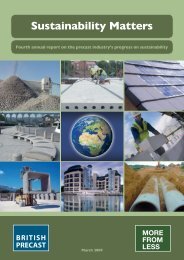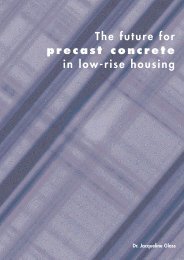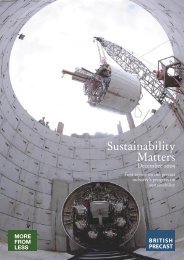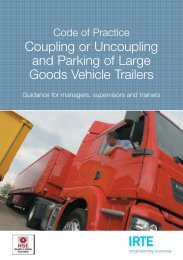The voice of concrete products - British Precast
The voice of concrete products - British Precast
The voice of concrete products - British Precast
You also want an ePaper? Increase the reach of your titles
YUMPU automatically turns print PDFs into web optimized ePapers that Google loves.
PRECAST CONCRETE SPECIAL EDITION<br />
Living with radon<br />
“Resistance to<br />
radon<br />
penetration is<br />
not the only<br />
benefit <strong>of</strong> a<br />
<strong>concrete</strong> beamand-block<br />
floor.<br />
Seepage <strong>of</strong><br />
methane on<br />
brownfield sites<br />
is also<br />
prevented, and<br />
acoustic<br />
performance is<br />
improved.”<br />
Figure 1 below: Beam<br />
and <strong>concrete</strong> flooring<br />
block with insulated<br />
overlayer – typical<br />
passive gas emission<br />
shown.<br />
Figure 2 below right:<br />
Beam and insulated<br />
flooring block – typical<br />
gas emission shown.<br />
Radon is a naturally occurring<br />
radioactive gas, formed during the<br />
decay <strong>of</strong> uranium in the ground. When<br />
it surfaces into the open air it is quickly<br />
diluted to a harmless concentration<br />
but if it enters a building it can become<br />
trapped and potentially dangerous<br />
levels can accumulate. Indeed, there<br />
are around 2500 deaths in the UK every<br />
year from lung cancer, linked directly<br />
to long-term exposure to high radon<br />
concentrations. This article explains<br />
how precast <strong>concrete</strong> beam-and-block<br />
flooring can deal with the challenge <strong>of</strong><br />
unwanted radon.<br />
George Pickard, <strong>Precast</strong> Flooring Federation<br />
Radon is found in all parts <strong>of</strong> the UK but is more prevalent<br />
in some areas. Places where the <strong>British</strong> Geological<br />
Survey (BGS) and the Health Protection Agency (HPA)<br />
have estimated that more than 1% <strong>of</strong> homes will contain<br />
elevated levels <strong>of</strong> radon are known as Affected Areas.<br />
Exposure is higher in Cornwall, Devon and Somerset, and<br />
there are hotspots in Wales, the Cotswolds and the Pennines.<br />
Surprisingly, radon is the most common source <strong>of</strong> exposure<br />
to radiation in Britain, exceeding that from nuclear power<br />
stations or hospital scans and X-rays.<br />
Floors and walls <strong>of</strong> dwellings contain many small cracks<br />
and gaps formed during and after construction. Any radon<br />
from the ground may be drawn into the building through<br />
these cracks and gaps because the atmospheric pressure<br />
inside the building is usually slightly lower than the pressure<br />
in the underlying soil. This small pressure difference is<br />
caused by the stack (or chimney) effect <strong>of</strong> heat in the building<br />
and by the effects <strong>of</strong> wind.<br />
Awareness <strong>of</strong> the risks has recently been highlighted<br />
by the HPA and BGS who have produced a new map <strong>of</strong><br />
affected areas in England and Wales, accessible via the<br />
website www.UKradon.org. Although the map gives<br />
estimates <strong>of</strong> the probability that properties would require<br />
action, the HPA has also advised that high radon levels can<br />
be found in basements anywhere in the country, regardless<br />
<strong>of</strong> Affected Area status.<br />
Significantly, an understanding <strong>of</strong> the risks posed by<br />
radon is relatively recent and in some areas <strong>of</strong> the country<br />
there are architects, developers and builders who have<br />
not previously had to consider radon reduction in houses.<br />
However, as radon-generating locations are being identified<br />
and recorded in greater detail, the need to be aware<br />
<strong>of</strong> and to deal with radon is becoming more <strong>of</strong> an issue on<br />
new-build housing projects.<br />
<strong>The</strong> gas flows into buildings as a result <strong>of</strong>:<br />
• the pressure <strong>of</strong> ongoing gas production<br />
• the stack effect<br />
• the wind<br />
• groundwater movement.<br />
When buildings are constructed on gas-contaminated<br />
land, the gas will generally seep upwards through openings<br />
such as construction joints and service penetrations, and<br />
build-up to dangerous concentrations if it becomes trapped,<br />
the extent <strong>of</strong> which largely depends on the local geology.<br />
<strong>The</strong> key phrase is ‘if it becomes trapped’, in which case<br />
there are two stages to control the situation. <strong>The</strong> first is to<br />
make sure that gas is separated from the living area <strong>of</strong> the<br />
building by an impermeable membrane across the whole<br />
footprint <strong>of</strong> the building and the second is to evacuate the<br />
gas continuously to the outside <strong>of</strong> the building where it will<br />
rapidly disperse.<br />
Section Cl (Resistance to Contaminants) <strong>of</strong> Schedule 1<br />
<strong>of</strong> the Building Regulations 2000 states that “Reasonable<br />
precautions shall be taken to avoid danger to health and<br />
safety caused by contaminants on or in the ground covered,<br />
or to be covered, by the building and any land associated<br />
with the building.” Further guidance is given in Approved<br />
Document C (2004 edition), where section 2.39 explains<br />
that, “To reduce the risk [to occupants <strong>of</strong> developing lung<br />
cancer] all new buildings, extensions and conversions,<br />
whether residential or non-domestic, built in areas where<br />
there may be elevated radon emissions, may need to incorporate<br />
precautions against radon.”<br />
<strong>The</strong> most straightforward and economic solution to<br />
such gas penetration is to use suspended precast <strong>concrete</strong><br />
flooring above a vented plenum. <strong>The</strong> <strong>concrete</strong> and membrane<br />
form an efficient passive barrier, while natural<br />
underfloor ventilation by way <strong>of</strong> vents and airbricks avoids<br />
any potential build-up. In extreme cases, active measures<br />
such as radon-laden air being extracted using a gas sump<br />
and mechanical ventilation may be required. This is generally<br />
the most effective method and will <strong>of</strong>ten reduce the<br />
34<br />
Reproduced f ro m CONCRETE December 2008/January 2009 © <strong>The</strong> Concrete So c i e t y, 2008


